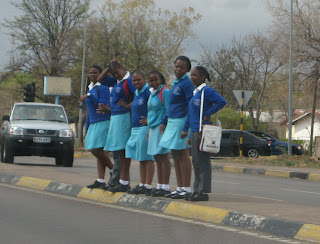We went with the Gublers and Taylors to visit Matsieng National Monument about a half hour north of Gaborone. The national monument consists of a slab of sandstone with holes in it that capture rain water. Most of these have clear water in them but one is covered with algae. It also has engravings of footprints that are thought to be about a thousand years old. The footprints come in all sizes from those of a child to prints larger than a man's.
According to legend Matsieng was the first ancestor of the Batswana people. Everyone lived with God in the center of the earth. Matsieng was a giant, one-legged man, who climbed out of one of the holes and was followed by his people, their domestic animals, and wildlife. so that they could live on the surface of the earth. Some religious groups come regularly to the holes to get water because they believe it is sacred.
Hole From Which Matsieng Emerged
The local guide had worked at the monument for seven years. He showed us which hole was the one Matsieng was believed to have emerged from. He explained that the holes were a source of water during the dry season and the deepest hole was nine meters deep and widened back out after becoming very narrow. All but the deepest hole used to dry up part of the year but with wells the water is used less and the holes no longer dry up. About a hundred years ago one tribe filled the holes with rocks and sand so that the local tribe would no longer have water during the dry season. Recently, most of the rocks and sand have been removed.





